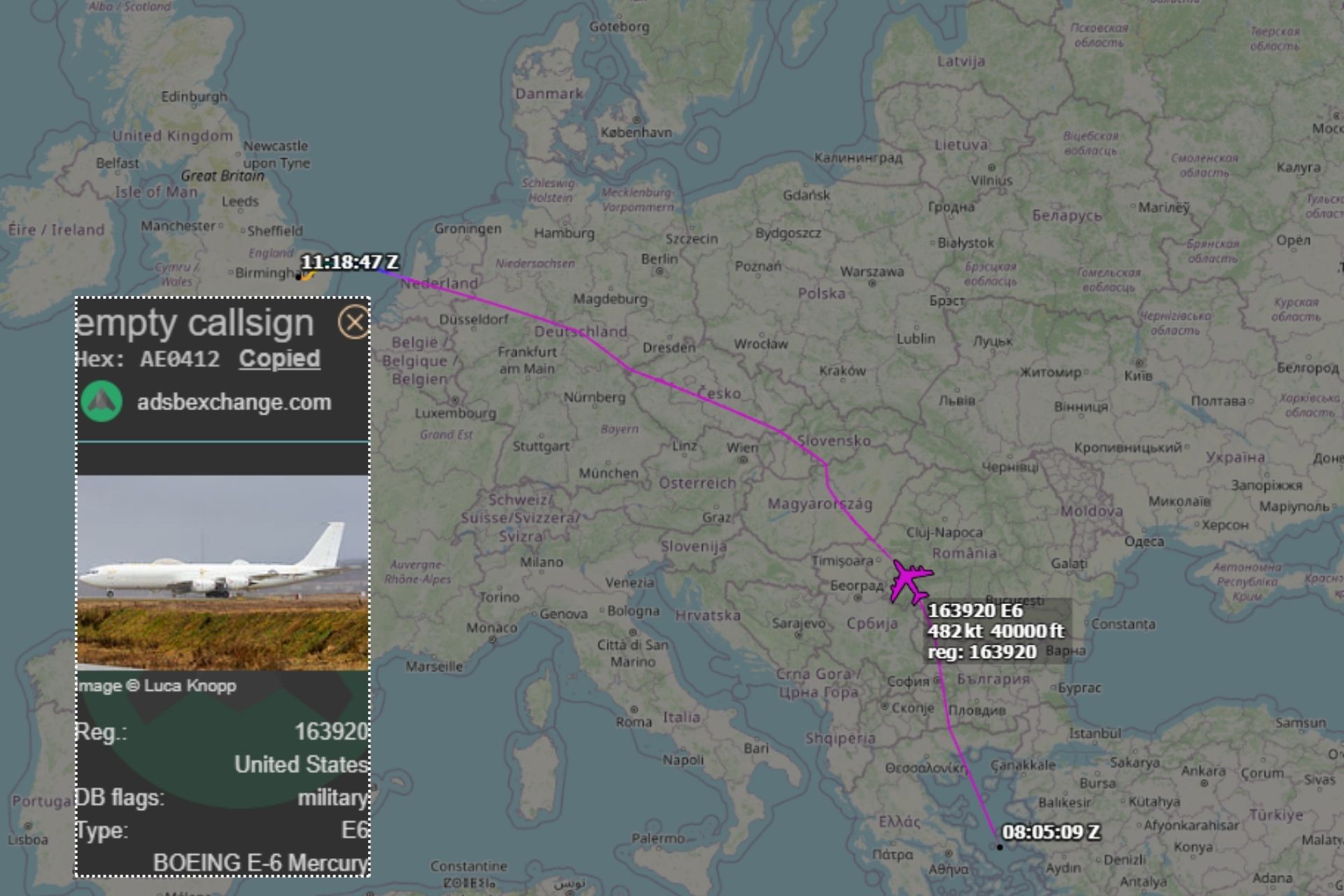90 seconds to midnight: US Judgement Day aircraft over Europe

{loadposition bannertop}
{loadposition sidebarpub}
Various live tracking sites have displayed an E-6B Mercury flying over the European continent towards the United Kingdom. Appearing on these sites at cruising altitude, this aircraft is capable of transmitting the presidential launch order to the U.S. Navy’s nuclear missile submarines and can also remotely command the firing of American ICBMs. Its clear presence is part of the U.S. nuclear deterrence, but the rarity of such a flight makes the situation particularly surprising. Indeed, the aircraft is perfectly visible on military radars, but the transponders detected by civilians on live tracking apps are rarely, if ever, activated on this type of aircraft.Follow Army Recognition on Google News at this link
The E-6B is a Communications Relay and Strategic Airborne Command Post Aircraft (Picture source: Northrop Grumman)
Strategic Surprise Over Europe
On September 4th, regular visitors to live tracking sites were surprised by the appearance of a U.S. Navy E-6B Mercury. This aircraft was not flying over the United States, as it often does, but instead appeared at 10:05 AM over the Aegean Sea (between Turkey and Greece) at an altitude of 12,192 meters and a speed of 874 km/h. The aircraft was already at cruising speed and altitude when it appeared, so its point of departure remains unknown. This departure location is particularly unclear since no flights had been recorded since August 30, when the Mercury conducted a very short flight around Tinker Air Force Base (Oklahoma, USA). Additionally, the Mercury wasn’t the only aircraft visible over the Aegean Sea; a KC-135 Stratotanker refueling plane was following the E-6B. It is highly likely that the KC-135 was responsible for refueling the U.S. Navy’s strategic aircraft during its flight.
Flight path of E-6B Mercury ” judgment day plane” ( Picture source: Army Recognition/ ADSBexchange)
A Crucial Aircraft
Developed for the U.S. Navy, the E-6B Mercury is equipped with highly advanced communication systems that keep it constantly connected to American command centers. The Mercury deploys two flexible VLF (Very Low Frequency) radio antennas: one 800 meters long and the other 8 kilometers long. While in flight, the Mercury executes tight turns to lower the antennas, creating a “tornado” effect with them. The more perpendicular the antennas are to the Earth’s surface, the more effective they become. These antennas enable the aircraft to transmit orders to the U.S. Navy’s nuclear missile submarines, including the presidential order to launch nuclear missiles.
The retirement of the U.S. Air Force’s EC-135 “Looking Glass” strategic communication and command aircraft created a capability gap in the American nuclear deterrence system. As a result, the E-6 Mercurys were upgraded to not only transmit orders but also directly control the launch of the U.S. Air Force’s intercontinental ballistic missiles (ICBMs) from a distance.
The E-6B Mercury is sometimes confused with the U.S. Air Force’s E-4B Nightwatch, another strategic command aircraft designed to host the highest civil and military authorities during major crises. The Nightwatch, also known as the “Doomsday Plane,” functions as a flying command center equipped with state-of-the-art communication technologies, including a single VLF antenna. While the President can order a nuclear strike from the E-4B, it is the E-6B that will receive and relay that order to the Strategic Forces. Therefore, the strategic command mission of the E-4B Nightwatch should not be confused with the communication relay and strategic command missions of the E-6B Mercury, which is also nicknamed after its mission TACAMO (Take Charge And Move Out).
A U.S. Navy E-6B Mercury assigned to United States Strategic Command Wing One arrived in Iceland,in 2023 (Picture source: US European Command)
A Show of Deterrence Over Europe
The flight of an aircraft capable of transmitting the launch order to the U.S. Navy’s ballistic missile submarines (SSBNs) and remotely commanding the launch of Minuteman III ICBMs is far from insignificant. For deterrence to be effective, a nation’s capabilities must be at least partially visible. This flight is part of the visible side of the iceberg that constitutes American nuclear deterrence. It also signals U.S. support at a time when tensions with Russia are particularly high. As of the writing of this article, the aircraft is flying over the Netherlands, following a typical route for U.S. military aircraft heading towards RAF Mildenhall (Suffolk, UK) or the nearby RAF Lakenheath.
This is not the first time a Mercury has flown over Europe; on February 28, 2023, an E-6B was temporarily deployed to Iceland, and more recently, on June 24, 2024, an E-6B practiced communications with a ballistic missile submarine off the coast of Norway by deploying its VLF antennas.

{loadposition bannertop}
{loadposition sidebarpub}
Various live tracking sites have displayed an E-6B Mercury flying over the European continent towards the United Kingdom. Appearing on these sites at cruising altitude, this aircraft is capable of transmitting the presidential launch order to the U.S. Navy’s nuclear missile submarines and can also remotely command the firing of American ICBMs. Its clear presence is part of the U.S. nuclear deterrence, but the rarity of such a flight makes the situation particularly surprising. Indeed, the aircraft is perfectly visible on military radars, but the transponders detected by civilians on live tracking apps are rarely, if ever, activated on this type of aircraft.
Follow Army Recognition on Google News at this link
The E-6B is a Communications Relay and Strategic Airborne Command Post Aircraft (Picture source: Northrop Grumman)
Strategic Surprise Over Europe
On September 4th, regular visitors to live tracking sites were surprised by the appearance of a U.S. Navy E-6B Mercury. This aircraft was not flying over the United States, as it often does, but instead appeared at 10:05 AM over the Aegean Sea (between Turkey and Greece) at an altitude of 12,192 meters and a speed of 874 km/h. The aircraft was already at cruising speed and altitude when it appeared, so its point of departure remains unknown. This departure location is particularly unclear since no flights had been recorded since August 30, when the Mercury conducted a very short flight around Tinker Air Force Base (Oklahoma, USA). Additionally, the Mercury wasn’t the only aircraft visible over the Aegean Sea; a KC-135 Stratotanker refueling plane was following the E-6B. It is highly likely that the KC-135 was responsible for refueling the U.S. Navy’s strategic aircraft during its flight.

Flight path of E-6B Mercury ” judgment day plane” ( Picture source: Army Recognition/ ADSBexchange)
A Crucial Aircraft
Developed for the U.S. Navy, the E-6B Mercury is equipped with highly advanced communication systems that keep it constantly connected to American command centers. The Mercury deploys two flexible VLF (Very Low Frequency) radio antennas: one 800 meters long and the other 8 kilometers long. While in flight, the Mercury executes tight turns to lower the antennas, creating a “tornado” effect with them. The more perpendicular the antennas are to the Earth’s surface, the more effective they become. These antennas enable the aircraft to transmit orders to the U.S. Navy’s nuclear missile submarines, including the presidential order to launch nuclear missiles.
The retirement of the U.S. Air Force’s EC-135 “Looking Glass” strategic communication and command aircraft created a capability gap in the American nuclear deterrence system. As a result, the E-6 Mercurys were upgraded to not only transmit orders but also directly control the launch of the U.S. Air Force’s intercontinental ballistic missiles (ICBMs) from a distance.
The E-6B Mercury is sometimes confused with the U.S. Air Force’s E-4B Nightwatch, another strategic command aircraft designed to host the highest civil and military authorities during major crises. The Nightwatch, also known as the “Doomsday Plane,” functions as a flying command center equipped with state-of-the-art communication technologies, including a single VLF antenna. While the President can order a nuclear strike from the E-4B, it is the E-6B that will receive and relay that order to the Strategic Forces. Therefore, the strategic command mission of the E-4B Nightwatch should not be confused with the communication relay and strategic command missions of the E-6B Mercury, which is also nicknamed after its mission TACAMO (Take Charge And Move Out).

A U.S. Navy E-6B Mercury assigned to United States Strategic Command Wing One arrived in Iceland,in 2023 (Picture source: US European Command)
A Show of Deterrence Over Europe
The flight of an aircraft capable of transmitting the launch order to the U.S. Navy’s ballistic missile submarines (SSBNs) and remotely commanding the launch of Minuteman III ICBMs is far from insignificant. For deterrence to be effective, a nation’s capabilities must be at least partially visible. This flight is part of the visible side of the iceberg that constitutes American nuclear deterrence. It also signals U.S. support at a time when tensions with Russia are particularly high. As of the writing of this article, the aircraft is flying over the Netherlands, following a typical route for U.S. military aircraft heading towards RAF Mildenhall (Suffolk, UK) or the nearby RAF Lakenheath.
This is not the first time a Mercury has flown over Europe; on February 28, 2023, an E-6B was temporarily deployed to Iceland, and more recently, on June 24, 2024, an E-6B practiced communications with a ballistic missile submarine off the coast of Norway by deploying its VLF antennas.





